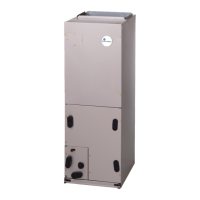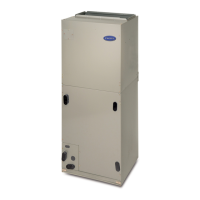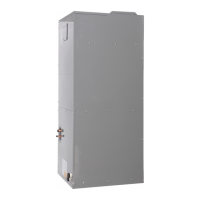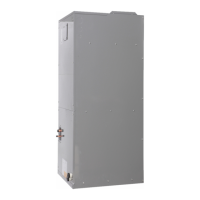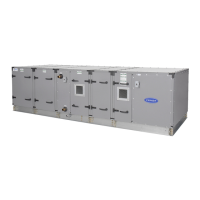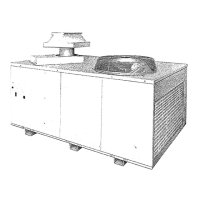15
CONTROL NAVIGATION
General
When using the Equipment Touch device to interface with the
LS-1628 controller, the screens, text, and options displayed will be
based upon the unit options and configuration for each unit. For
example, if a unit does not have heat, the heating set point, heating
status screen, heating PID screen, and heating related alarms will
not be displayed. The unit will not perform any heating related
tests during test mode.
Standby Screen
Standby screen is displayed when the Equipment Touch has been
idle for a preset period. See Fig. 7.
Fig. 7 — Standby Screen
The Standby screen will show the controller date and time (top
right corner) and the current operating condition/mode (bottom of
screen). Use the press to continue button or back button to exit the
Standby screen and open the last screen viewed prior to standby.
Use the home button to exit to the home screen.
Home Screen
The Home screen is the main access point to all additional screens
and displays the current unit operating mode/condition. The Home
screen can be accessed at any time by pressing the Home icon on
the top bar. See Fig. 8.
Fig. 8 — Home Screen
When an alarm is active, the top portion of the Home screen will
show the Reset Alarm function. To reset all active alarms, click on
the down arrow next to “No” and change the value to “Yes”. “Yes”
will display for 5 seconds and then change back to “No”. After a
2-minute delay, the Reset Alarm function will disappear if no ac-
tive alarms exist.
The main portion of the Home screen contains links to status
screens for individual components or modes. Pressing any of the
component names will bring you to the associated status screen.
The Home screen also contains a link to the Set Point screen (Stp/
DB) and the Technical Settings (Setup) screen.
Status Screens
Status screens can be accessed from the Home screen and will
show relevant information for the listed component or system,
such as operating status, modulation status, alarm status, sensor
readings, and set points. See Fig. 9.
Status screens do not allow for editing of information and do not
require a password to access. The bottom of the status screen may
contain links to other related screens, such as related components,
set points, or tech settings screens.
Damper Status
The Damper Status screen shows the status of the outdoor air
damper and the status of the smoke detector (if equipped) and the
energy management or emergency management relay (if config-
ured). See Fig. 9.
Fig. 9 — Damper Status Screen
The following statuses are available on the Damper status screen:
• OAD Status is the command of the Outside Air Damper
(BO6) on the expansion board (CLOSE/OPEN)
• OADA is the status feedback from the OD auxiliary con-
tact (CLOSED/OPENED), the Supply Fan will not start
until this status is OPENED.
• SD Status will show either NORMAL (N.C.) or ALARM
(N.O.).
• EMR is the status for an Emergency/Energy Management
Relay (N.C.), which is field wired to UI-27 of the expander
module. The EMR will show as ALARM when the relay is
open or NORMAL when the relay is closed. See EMR on
the Misc. Options B screen under Unit Control Config
(Home
Setup
Unit Config.).
The Supply Fan Status screen shows the status and parameters for
the supply fan (SF) and the clogged filter indicator (CFI). See
Fig. 10.
Fig. 10 — Supply Fan Status Screen

